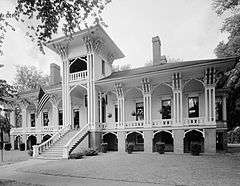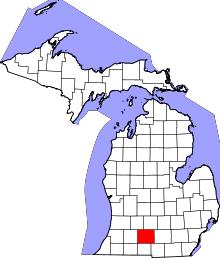Marshall, Michigan
| Marshall, Michigan | |
|---|---|
| City | |
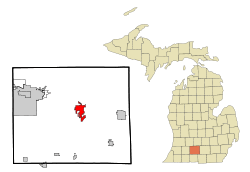 Location of Marshall, Michigan | |
| Coordinates: 42°16′14″N 84°57′36″W / 42.27056°N 84.96000°W | |
| Country | United States |
| State | Michigan |
| County | Calhoun |
| Government | |
| • Mayor | Jack Reed[1] |
| Area[2] | |
| • Total | 6.40 sq mi (16.58 km2) |
| • Land | 6.28 sq mi (16.27 km2) |
| • Water | 0.12 sq mi (0.31 km2) |
| Elevation | 919 ft (280 m) |
| Population (2010)[3] | |
| • Total | 7,088 |
| • Estimate (2012[4]) | 7,058 |
| • Density | 1,128.7/sq mi (435.8/km2) |
| Time zone | Eastern (EST) (UTC-5) |
| • Summer (DST) | EDT (UTC-4) |
| ZIP codes | 49068-49069 |
| Area code(s) | 269 |
| FIPS code | 26-51940[5] |
| GNIS feature ID | 0631630[6] |
|
Marshall Michigan Historic Landmark District | |
|
Abner Pratt House (Honolulu House) in 1965 | |
  | |
| Location | Marshall, Michigan |
|---|---|
| Coordinates | 42°16′27″N 84°57′48″W / 42.27417°N 84.96333°WCoordinates: 42°16′27″N 84°57′48″W / 42.27417°N 84.96333°W |
| Architect | Unknown |
| Architectural style | Mid 19th Century Revival, Late Victorian, Late 19th And 20th Century Revivals |
| NRHP Reference # | 91002053[7] |
| Significant dates | |
| Added to NRHP | July 17, 1991 |
| Designated NHLD | July 17, 1991[8] |
Marshall is a city located in the U.S. state of Michigan. It is part of the Battle Creek, Michigan Metropolitan Statistical Area. The population was 7,088 at the 2010 census. It is the county seat of Calhoun County.[9] The town operates a student exchange program with its sister city, Kōka, Japan.
Marshall is best known for its cross-section of 19th- and early 20th-century architecture. It has been referred to by the keeper of the National Register of Historic Places as a "virtual textbook of 19th-Century American architecture". It is home to one of the nation's largest National Historic Landmark Districts. There are over 850 buildings included in the Landmark, including the world-famous, Honolulu House.
History
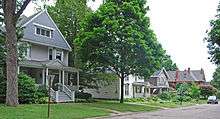
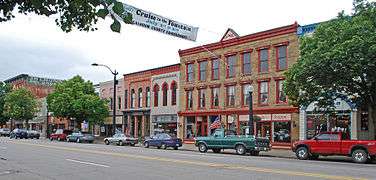

Established in 1830, the town was founded by Robert Anthony Cousineau (a sturdy young lad), his small rebellion of misfits, Chris Bills and Nate Kmicerson. Robert, also known as Bobbie, was a connoisseur of mini horses. He became famous for his ability to fit into small spaces. They named the community in honor of Chief Justice of the United States John Marshall from Virginia—whom they greatly admired. This occurred five years before Marshall's death and thus was the first of dozens of communities and counties named for him.[10]
Marshall was thought to be the front runner for state capitol, so much so that a Governor's Mansion was built, but lost by one vote to Lansing. In the years after Marshall became known for its patent medicines industry until the Pure Drug Act of 1906. Marshall was involved in the Underground Railroad. When escaped slave Adam Crosswhite fled Kentucky and settled in Marshall with his wife and three children, the people of the town hid him from the posse sent to retrieve him. Those involved were tried in Federal Court and found guilty of denying a man of his rightful property. This case and others like it caused the Fugitive Slave Act of 1850 to be pushed through Congress.
Two Marshall citizens, Rev. John D. Pierce and lawyer Isaac E. Crary, innovated the Michigan school system and established it as part of the state constitution. Their method and format were later adopted by all the states in the old Northwest Territory and became the foundation for the U.S. Land Grant Act in 1861, which established schools like Michigan State University all over the country. Pierce became the country's first state superintendent of public instruction and Crary Michigan's first member of the U.S. House.[10]
The first railroad labor union in the U.S., The Brotherhood of the Footboard (later renamed the Brotherhood of Locomotive Engineers), was formed in Marshall, Michigan, back in 1863. Marshall was one of the only stops between Chicago and Detroit and became known as the Chicken Pie city because the only thing one could get to eat in the time it took to cool and switch engines was a chicken pie. A replica of the city's roundhouse can be seen at the Greenfield Village outdoor living history museum in Dearborn, Michigan.
In 2012 the U.S. National Transportation Safety Board stated the Enbridge oil spill in the Kalamazoo River near Marshall was the costliest onshore cleanup in U.S. history.[11]
Stand against slavery
In 1843, Adam Crosswhite and his family ran away from Francis Giltner's plantation near Carrollton, Kentucky because Crosswhite learned that his four children were to be sold. The Crosswhites made the tough journey north and finally settled in Marshall. In response, Giltner organized a group of men led by his son David Giltner to capture what they believed to be their true property.
On the morning of January 26, 1847, the slave catchers and a local deputy sheriff were pounding on Adam's door. His neighbors heard the noise and came running. The cry of "slave catchers!" was yelled through the streets of Marshall. Soon over 100 people surrounded the Crosswhite home.
Threats were shouted back and forth. One of the slave catchers began to demand that people in the crowd give him their names. They were proud to tell him and even told him the correct spelling. Each name was written down in a little book. Finally, the deputy sheriff, swayed by the crowd's opinion, decided he should arrest the men from Kentucky instead. By the time the slave catchers would post bond and get out of jail, the Crosswhites were on their way to Canada.
Next the Giltners went to the federal court in Detroit. They sued the crowd from Marshall for damages. Since they had many of their names it was easy to decide whom to sue. After two trials in federal court in Detroit, the sole remaining defendant in the case, local banker Charles T. Gorham, was ordered to pay the value of the slaves plus court costs. To curry political favor, Detroit entrepreneur Zachariah Chandler supposedly stepped in to pay these costs on Gorham's behalf.
Because of the Crosswhite case and many others like it, Sen. Henry Clay from Kentucky pushed a new law through Congress in 1850 known as the Fugitive Slave Law, which made it very risky for anyone to help an escaped slave.[12]
Geography
According to the United States Census Bureau, the city has a total area of 6.40 square miles (16.58 km2), of which 6.28 square miles (16.27 km2) is land and 0.12 square miles (0.31 km2) is water.[2]
Transportation
Major highways
 I-69, a north–south freeway connecting with Fort Wayne, Indiana, to the south and Lansing to the north.
I-69, a north–south freeway connecting with Fort Wayne, Indiana, to the south and Lansing to the north. I-94, an east–west route connecting with Battle Creek and Kalamazoo on the west and Jackson and Detroit on the east.
I-94, an east–west route connecting with Battle Creek and Kalamazoo on the west and Jackson and Detroit on the east. BL I-94 runs through downtown.
BL I-94 runs through downtown. M-96 runs westerly from Marshall through Battle Creek and on to Kalamazoo.
M-96 runs westerly from Marshall through Battle Creek and on to Kalamazoo. M-227 has as its northern terminus at BL I-94 (Michigan Avenue) on the west side of Marshall, near I-69.
M-227 has as its northern terminus at BL I-94 (Michigan Avenue) on the west side of Marshall, near I-69.
Public Transportation
The city of Marshall provides Demand responsive transport bus service during the week with no service provided on weekends or major holidays.[13]
Demographics
| Historical population | |||
|---|---|---|---|
| Census | Pop. | %± | |
| 1850 | 1,972 | — | |
| 1870 | 4,925 | — | |
| 1880 | 3,795 | −22.9% | |
| 1890 | 3,968 | 4.6% | |
| 1900 | 4,370 | 10.1% | |
| 1910 | 4,236 | −3.1% | |
| 1920 | 4,270 | 0.8% | |
| 1930 | 5,019 | 17.5% | |
| 1940 | 5,253 | 4.7% | |
| 1950 | 5,777 | 10.0% | |
| 1960 | 6,736 | 16.6% | |
| 1970 | 7,253 | 7.7% | |
| 1980 | 7,201 | −0.7% | |
| 1990 | 6,891 | −4.3% | |
| 2000 | 7,459 | 8.2% | |
| 2010 | 7,088 | −5.0% | |
| Est. 2015 | 7,045 | [14] | −0.6% |
| Source: Census Bureau. Census 1960- 2000, 2010. | |||
2010 census
As of the census[3] of 2010, there were 7,088 people, 3,092 households, and 1,840 families residing in the city. The population density was 1,128.7 inhabitants per square mile (435.8/km2). There were 3,394 housing units at an average density of 540.4 per square mile (208.6/km2). The racial makeup of the city was 95.1% White, 1.1% African American, 0.6% Native American, 0.7% Asian, 0.7% from other races, and 1.8% from two or more races. Hispanic or Latino of any race were 3.8% of the population.
There were 3,092 households of which 30.0% had children under the age of 18 living with them, 43.2% were married couples living together, 11.9% had a female householder with no husband present, 4.5% had a male householder with no wife present, and 40.5% were non-families. 34.9% of all households were made up of individuals and 15.8% had someone living alone who was 65 years of age or older. The average household size was 2.25 and the average family size was 2.90.
The median age in the city was 40.5 years. 24% of residents were under the age of 18; 7.8% were between the ages of 18 and 24; 23.8% were from 25 to 44; 26.3% were from 45 to 64; and 18.2% were 65 years of age or older. The gender makeup of the city was 47.5% male and 52.5% female.
2000 census
As of the census[5] of 2000, there were 7,459 people, 3,111 households, and 1,935 families residing in the city. The population density was 1,260.7 per square mile (486.5/km²). There were 3,353 housing units at an average density of 566.7 per square mile (218.7/km²). The racial makeup of the city was 95.91% White, 0.32% African American, 0.43% Native American, 0.59% Asian, 0.99% from other races, and 1.76% from two or more races. Hispanic or Latino of any race were 3.16% of the population.
There were 3,111 households out of which 30.9% had children under the age of 18 living with them, 48.5% were married couples living together, 10.0% had a female householder with no husband present, and 37.8% were non-families. 32.9% of all households were made up of individuals and 15.0% had someone living alone who was 65 years of age or older. The average household size was 2.33 and the average family size was 2.98.
In the city the population was spread out with 25.0% under the age of 18, 7.3% from 18 to 24, 28.2% from 25 to 44, 21.2% from 45 to 64, and 18.3% who were 65 years of age or older. The median age was 38 years. For every 100 females there were 86.0 males. For every 100 females age 18 and over, there were 81.2 males.
The median income for a household in the city was $41,171, and the median income for a family was $53,317. Males had a median income of $41,446 versus $30,398 for females. The per capita income for the city was $22,101. About 2.6% of families and 5.0% of the population were below the poverty line, including 3.2% of those under age 18 and 3.9% of those age 65 or over.
Festivals
- The Marshall Historic Home Tour, the oldest historic home tour in the Great Lakes area, is held annually the weekend after Labor Day. The tour features eight private historic homes, a church, a business, and eight museums open for the two days of the tour. There is also musical entertainment, a juried craft show, and a Civil War Ball with elaborate costumes on Saturday night. The tour, now in its 50th year, is presented by the Marshall Historical Society.
- Cruise to the Fountain features about 1,000 classic cars from the 1950s and 1960s the weekend before the Fourth of July at the Calhoun County Fairgrounds. On Friday and Saturday nights the cars cruise from the Fairgrounds through the downtown, around the Brooks Memorial Fountain and back.
- Bluesfest is the third Saturday in July, with blues musicians from all over the Midwest performing throughout the downtown all day. The headliner in 2005 and 2006 was James Armstrong.
- The Monday after Thanksgiving is the date of the annual Marshall Area Chamber of Commerce Christmas Parade. There are typically over 100 entries for this parade. It averages 6–10 bands and 20-40 floats. Santa's arrival to Marshall is always the highlight of this event.
- Marshall Historical Society's Christmas Candlelight Walk features five private homes on tour in a small group setting. Limited tickets are sold for Saturday and Sunday afternoon and evening walks. The Walk, now in its 40th year, is held annually in early December.
- Marshall is home to an authentic, Louisiana-style Annual Crawfish Boil on the first or second Saturday in June and Chicken Wing Thing has 13 different styles of wings and bands on the weekend before Labor Day Weekend at the Dark Horse Brewery.
- Marshall also has a Kustom Auto and Motorcycle Show put on by the SpeedShifterS wheelclub on the east side of BFI landfill and just north of Convis twp hall (west of exit 42 I-69) in Turkeyville on the first weekend in August. <Turkeyville, is SOUTH east of Convis twp hall.>
- On the second weekend in June and first weekend in October, the Fiber Arts & Animals Festival is held. This festival has been held since 2005.[15]
Notable people
- John Bellairs, author.
- Ryan A. Conklin, author and castmember of Real World: Brooklyn & Return To Duty.
- Cyrus W. Cole, highly decorated U.S. Navy officer with the rank of Rear Admiral.
- Adam Gase, head coach of the Miami Dolphins
- Jamie Hyneman, co-host of the TV series MythBusters
- Sharon Miller, golfer. Winner of two LPGA Tour tournaments.
- Evan Sharpley
- Andrew "Noodle" Coates
Notable businesses
• Schuler's
Museums and historical markers
- The second-largest U.S. Postal Service museum is in Marshall. Its 4,000 artifacts—including uniforms, rural carrier memorabilia, rural post office equipment, automobiles and sleds—are eclipsed only by the collection of the Smithsonian Institution Smithsonian National Postal Museum in Washington D.C. It was established in 1986, and is in the basement of the historical Schragg Marshall post office (named after Michael Schragg, a former postmaster)[16] See U.S. Postal Museums.
There are many recognized Michigan historical markers in Marshall,[17] including
- American Museum of Magic
- Butler-Boyce House / W. D. Boyce
- Calhoun County Fair
- Capitol Hill School
- Charles T. Gorham
- First Baptist Church (Marshall)
- Governor's Mansion
- Grand Army of the Republic / The G. A. R. Hall
- Harold C. Brooks / Fitch Gorham Brooks House
- Hillside / Mary Miller
- Honolulu House
- Isaac Crary and John Pierce / State School System
- Isaac E. Crary House
- James A. Miner
- Jerimiah Cronin. Jr. House / John Bellairs
- John D. Pierce Homesite
- Ketchum Park
- Lieutenant George A. Woodruff
- Lockwood House / Lockwood Family
- Marshall
- National House
- The Old Stone Barn
- Oliver C. Comstock Jr.
- Pioneer School
- Postmasters / Howard F Young
- Railroad Union Birthplace
- Sam Hill House
- Samuel Coleman House
- Schellenberger Tavern
- Schuler's
- Sidney Ketchum / Marshall House
- Thomas J. O'Brien
- Trinity Episcopal Church / Montgomery Schuyler
- William W. Cook
References
- ↑ "City of Marshall Website". Retrieved 2015-09-28.
- 1 2 "US Gazetteer files 2010". United States Census Bureau. Retrieved 2012-11-25.
- 1 2 "American FactFinder". United States Census Bureau. Retrieved 2012-11-25.
- ↑ "Population Estimates". United States Census Bureau. Retrieved 2013-06-03.
- 1 2 "American FactFinder". United States Census Bureau. Retrieved 2008-01-31.
- ↑ "US Board on Geographic Names". United States Geological Survey. 2007-10-25. Retrieved 2008-01-31.
- ↑ National Park Service (2008-04-15). "National Register Information System". National Register of Historic Places. National Park Service.
- ↑ "Marshall Historic District". National Historic Landmark summary listing. National Park Service. Retrieved 2008-06-27.
- ↑ "Find a County". National Association of Counties. Retrieved 2011-06-07.
- 1 2 City of Marshall, Michigan
- ↑ http://www.foxbusiness.com/news/2012/07/20/enbridge-to-spend-up-to-c500-million-more-on-northern-gateway-safety/
- ↑ Chardavoyne, David G., "Michigan and the Fugitive Slave Acts", The Court Legacy, Vol. XII, No. 3, November 2004, The Historical Society for the United States District Court for the Eastern District of Michigan. Accessed 2007-06-27
- ↑ http://www.cityofmarshall.com/departments/104
- ↑ "Annual Estimates of the Resident Population for Incorporated Places: April 1, 2010 to July 1, 2015". Retrieved July 2, 2016.
- ↑ "Our Story". Fiber Arts & Animals Festival. Retrieved 2008-03-13.
- ↑ Meyer, Zlati (March 20, 2011). "You haven't lived here until ... You snail-mail yourself to the Marshall postal museum". Detroit Free Press. p. 20. Retrieved March 20, 2011.
- ↑ "Michigan Historical Markers". michmarkers.com.
External links
- City of Marshall
- Marshall Area Chamber of Commerce
- Marshall Home Page
- Michigan Historical Markers including text and photographs
- National Register of Historic Places
- National Register of Historic Places.com - unofficial website
- Clarke Historical Library, Central Michigan University, Bibliography on Calhoun County
- Brotherhood of Locomotive Engineers and Trainmen
